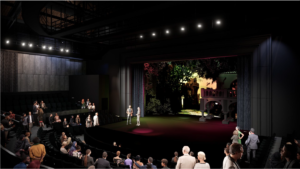This piece previously appeared on the Finer Points blog.
Each fall, the University of Utah community buzzes with energy – students move in to dorms and fill the sidewalks with excited conversation, plans begin for upcoming performances and exhibitions, the beautiful mountain backdrop changes color, and fans anxiously await football’s opening day in Rice Eccles Stadium.
Perhaps this year, more than before (we missed it all so much!) being on campus feels special.
One building in particular is showing off a fresh new coat of paint: the Einar Nielsen Fieldhouse.
 Originally opened in 1939, the Einar Nielsen Fieldhouse has been central in the memories of U students, and acted as home for U athletes for decades. From 1939 to 1969, the Runnin’ Utes basketball team played there to adoring crowds. Students took physical education within its walls. It was even retrofitted to hold soldiers during WWII.
Originally opened in 1939, the Einar Nielsen Fieldhouse has been central in the memories of U students, and acted as home for U athletes for decades. From 1939 to 1969, the Runnin’ Utes basketball team played there to adoring crowds. Students took physical education within its walls. It was even retrofitted to hold soldiers during WWII.
Many will remember in 2015 when the rooftop of the Fieldhouse was first painted in proud block letters reading “UTAH,” the result of an enthusiastic crowdfunding campaign. Recently, the roof was repainted after major seismic renovations to the building.
In just a few short weeks, fans will enjoy these familiar rooftop letters as they cheer on the Utah Utes. What is perhaps lesser-known is what is happening inside the historic structure.

Rendering, new theatre at the Einar Nielsen Fieldhouse
A new space for the arts
The College of Fine Arts is hard at work regenerating the beloved Einar Nielsen Fieldhouse into a new, state-of-the-art, 375-seat theatre. Thanks to a landmark gift from the Meldrum Foundation, this long-awaited space will be home to both the Department of Theatre and Pioneer Theatre Company productions. Providing a much-needed proscenium performance venue for the Department of Theatre and a suitable space for Pioneer Theatre Company’s contemporary plays that require a more intimate audience, the project brings new life to a historic structure while meeting central needs.
As an added bonus, the theatre will encourage consistent collaboration between students and professional working artists.
So, as you make your way to a game, stroll through lower campus on your way to class, or wave as you drive by the old Fieldhouse, know that this long-standing landmark is newly thriving, ushering in a bright new chapter for the arts in Utah.
